Spatiotemporal Evolution of Urban Rain Islands in China under the Conditions of Urbanization and Climate Change
Abstract
:1. Introduction
2. Method
2.1. Data Sources and Preprocessing
2.2. Classification of Urban and Suburban Areas
2.3. Absolute Humidity
2.4. Urban Artificial Water Dissipation
2.5. Conceptual Model of the Rain Island Effect
3. Results
3.1. Spatial Distribution of Urban Precipitation
3.2. Annual Analysis of the Rain Island Effect
3.3. Seasonal Variations in the Rain Island Effect
3.4. Changes in the Rain Island Effect Following Urbanization
4. Discussion
5. Conclusions
- The rain island effect (0–31.6 mm/month) was mainly distributed along the southeast coast and northwest inland regions. The heat island effect was the dominant driver of the rain island effect in coastal areas, while artificial water dissipation and the heat island effect were both found to influence the urban rain island effect in the northwest inland region.
- The summer distribution of rain island effects and absolute humidity was generally consistent with the annual distribution because most of the region’s precipitation occurs during summer. During winter, the relative contribution of urban artificial water dissipation was higher, and the rain island effect was more pronounced.
- Following urbanization, urban precipitation and rain island intensity increased along the southeast coast and in the northwest inland region. Intensification of the rain island effect was most apparent along the southeast coast, which was the region with the highest degree of urbanization.
- Rain island effects were more pronounced in winter compared to those in summer. When the absolute humidity of urban areas increased by less than 4% in winter, the rain island effect was weakened. Conversely, when the absolute humidity of urban areas increased by more than 4% in winter, the rain island effect was enhanced. Artificial water dissipation is an important water vapor source for urban precipitation.
Supplementary Materials
Author Contributions
Funding
Data Availability Statement
Conflicts of Interest
References
- Alexander, L.V.; Zhang, X.; Peterson, T.C.; Caesar, J.; Gleason, B.; Tank, A.M.G.K.; Haylock, M.; Collins, D.; Trewin, B.; Rahimzadeh, F.; et al. Global observed changes in daily climate extremes of temperature and precipitation. J. Geophys. Res.-Atmos. 2006, 111, 1–22. [Google Scholar] [CrossRef]
- Kug, J.S.; Ahn, M.S. Impact of urbanization on recent temperature and precipitation trends in the Korean peninsula. Asia-Pac. J. Atmos. Sci. 2013, 49, 151–159. [Google Scholar] [CrossRef]
- Thielen, J.; Wobrock, W.; Gadian, A.; Mestayer, P.G.; Creutin, J.D. The possible influence of urban surfaces on rainfall development: A sensitivity study in 2D in the meso-γ-scale. Atmos. Res. 2000, 54, 15–39. [Google Scholar] [CrossRef]
- Grimm, N.B.; Faeth, S.H.; Golubiewski, N.E.; Redman, C.L.; Wu, J.; Bai, X.; Briggs, J.M. Global change and the ecology of cities. Science 2008, 319, 756–760. [Google Scholar] [CrossRef] [PubMed]
- Gong, P.; Li, X.; Zhang, W. 40-Year (1978–2017) human settlement changes in China reflected by impervious surfaces from satellite remote sensing. Sci. Bull. 2019, 64, 756–763. [Google Scholar] [CrossRef]
- Ma, J.; Chadwick, R.; Seo, K.-H.; Dong, C.; Huang, G.; Foltz, G.R.; Jiang, J.H. Responses of the Tropical Atmospheric Circulation to Climate Change and Connection to the Hydrological Cycle. Annu. Rev. Earth Planet. Sci. 2018, 46, 549–580. [Google Scholar] [CrossRef]
- Zhang, N.; Zhu, L.; Zhu, Y. Urban heat island and boundary layer structures under hot weather synoptic conditions: A case study of Suzhou City, China. Adv. Atmos. Sci. 2011, 28, 855–865. [Google Scholar] [CrossRef]
- Hu, H.; Tian, Z.; Sun, L.; Wen, J.; Liang, Z.; Dong, G.; Liu, J. Synthesized trade-off analysis of flood control solutions under future deep uncertainty: An application to the central business district of Shanghai. Water Res. 2019, 166, 115067. [Google Scholar] [CrossRef]
- Westra, S.; Alexander, L.; Zwiers, F. Global Increasing Trends in Annual Maximum Daily Precipitation. J. Clim. 2013, 26, 7834. [Google Scholar] [CrossRef]
- Zhang, Y.; Pang, X.; Xia, J.; Shao, Q.; Yu, E.; Zhao, T.; She, D.; Sun, J.; Yu, J.; Pan, X.; et al. Regional Patterns of Extreme Precipitation and Urban Signatures in Metropolitan Areas. J. Geophys. Res.-Atmos. 2019, 124, 641–663. [Google Scholar] [CrossRef]
- Jiang, T.; Su, B.; Huang, J.; Zhai, J.; Kundzewicz, Z.W. Each 0.5 °C of warming increases annual flood losses in China by more than 60 billion USD. B Am. Meteorol. Soc. 2020, 101, E1464–E1474. [Google Scholar] [CrossRef]
- Man, H.; Berg, H.; Leenen, E.; Schijven, J.; Schets, F.; Vliet, J.; Knapen, F.; Husman, A. Quantitative assessment of infection risk from exposure to waterborne pathogens in urban floodwater. Water Res. 2014, 48, 90–99. [Google Scholar] [CrossRef] [PubMed]
- Muthusamy, M.; Wani, O.; Schellart, A.; Tait, S. Accounting for variation in rainfall intensity and surface slope in wash-off model calibration and prediction within the Bayesian framework. Water Res. 2018, 143, 561–569. [Google Scholar] [CrossRef] [PubMed]
- Parajulee, A.; Lei, Y.D.; Kananathalingam, A.; McLagan, D.S.; Mitchell, C.P.J.; Wania, F. The transport of polycyclic aromatic hydrocarbons during rainfall and snowmelt in contrasting landscapes. Water Res. 2017, 124, 407–414. [Google Scholar] [CrossRef]
- Zhao, Y.; Xia, J.; Xu, Z.; Zou, L.; Qiao, Y.; Li, P. Impact of Urban Expansion on Rain Island Effect in Jinan City, North China. Remote Sens. 2021, 13, 2989. [Google Scholar] [CrossRef]
- Han, L.; Wang, L.; Chen, H.; Xu, Y.; Sun, F.; Reed, K.; Deng, X.; Li, W. Impacts of Long-Term Urbanization on Summer Rainfall Climatology in Yangtze River Delta Agglomeration of China. Geophys. Res. Lett. 2022, 49, e2021GL097546. [Google Scholar] [CrossRef]
- Li, H.; Zhai, P.; Lu, E.; Zhao, W.; Chen, Y.; Wang, H. Changes in Temporal Concentration Property of Summer Precipitation in China during 1961–2010 Based on a New Index. J. Meteorol. Res. 2017, 31, 336–349. [Google Scholar] [CrossRef]
- Zhang, J.; Zhao, T.; Dai, A.; Zhang, W. Detection and Attribution of Atmospheric Precipitable Water Changes since the 1970s over China. Sci. Rep. 2019, 9, 17609. [Google Scholar] [CrossRef]
- Luo, Z.; Liu, J.; Zhang, Y.; Zhou, J.; Shao, W. Influence of urbanization on spatial distribution of extreme precipitation in Henan Province. Water Resour. Prot. 2022, 38, 100–105. (In Chinese) [Google Scholar] [CrossRef]
- Sun, S.; Barraud, S.; Castebrunet, H.; Aubin, J.-B.; Marmonier, P. Long-term stormwater quantity and quality analysis using continuous measurements in a French urban catchment. Water Res. 2015, 85, 432–442. [Google Scholar] [CrossRef]
- Chen, S.; Li, W.; Du, Y.; Mao, C.; Zhang, L. Urbanization effect on precipitation over the Pearl River Delta based on CMORPH data. Adv. Clim. Change Res. 2015, 6, 16–22. [Google Scholar] [CrossRef]
- Wang, J.; Feng, J.; Yan, Z. Potential sensitivity of warm season precipitation to urbanization extents: Modeling study in Beijing-Tianjin-Hebei urban agglomeration in China. J. Geophys. Res.-Atmos. 2015, 120, 9408–9425. [Google Scholar] [CrossRef]
- Changnon, S. Rainfall changes in summer caused by St. Louis. Science 1979, 205, 4404. [Google Scholar] [CrossRef]
- Shem, W.; Shepherd, M. On the impact of urbanization on summertime thunderstorms in Atlanta: Two numerical model case studies. Atmos. Res. 2009, 92, 172–189. [Google Scholar] [CrossRef]
- Zhang, W.; Villarini, G.; Vecchi, G.A.; Smith, J.A. Urbanization exacerbated the rainfall and flooding caused by hurricane Harvey in Houston. Nature 2018, 563, 384–388. [Google Scholar] [CrossRef] [PubMed]
- Rosenfeld, D. Suppression of rain and snow by urban and industrial air pollution. Science 2000, 287, 5459. [Google Scholar] [CrossRef]
- Zhong, S.; Qian, Y.; Zhao, C.; Leung, R.; Liu, D. Urbanization-induced urban heat island and aerosol effects on climate extremes in the Yangtze River Delta region of China. Atmos. Chem. Phys. 2017, 17, 5439–5457. [Google Scholar] [CrossRef]
- Song, X.; Zhang, J.; AghaKouchak, A.; Roy, S.S.; Xuan, Y.; Wang, G.; He, R.; Wang, X.; Liu, C. Rapid urbanization and changes in spatiotemporal characteristics of precipitation in Beijing metropolitan area. J. Geophys. Res.-Atmos. 2014, 119, 11250–11271. [Google Scholar] [CrossRef]
- Chen, D.; Liu, W.; Huang, F.; Li, Q.; Li, L. Spatial-temporal characteristics and influencing factors of relative humidity in arid region of Northwest China during 1966–2017. J. Arid Land 2020, 12, 397–412. [Google Scholar] [CrossRef]
- Wan, H.; Zhong, Z.; Yang, X.; Li, X. Impact of city belt in Yangtze River Delta in China on a precipitation process in summer: A case study. Atmos. Res. 2013, 125, 63–75. [Google Scholar] [CrossRef]
- Wang, R.; Zhu, Y.; Qiao, F.; Liang, X.; Ding, Y. High-resolution Simulation of an Extreme Heavy Rainfall Event in Shanghai Using the Weather Research and Forecasting Model: Sensitivity to Planetary Boundary Layer Parameterization. Adv. Atmos. Sci. 2021, 38, 98–115. [Google Scholar] [CrossRef]
- Yair, A.; Raz-Yassif, N. Hydrological processes in a small arid catchment: Scale effects of rainfall and slope length. Geomorphology 2004, 61, 155–169. [Google Scholar] [CrossRef]
- Ma, S.; Zhou, T.; Dai, A.; Han, Z. Observed Changes in the Distributions of Daily Precipitation Frequency and Amount over China from 1960 to 2013. J. Clim. 2015, 28, 6960–6978. [Google Scholar] [CrossRef]
- Kong, F.; Sun, S. Spatiotemporal variation pattern of rainfall in land area of the Belt and Road during 1901–2018. Water Resour. Hydropower Eng. 2021, 52, 1–10. [Google Scholar] [CrossRef]
- Luo, Z.; Liu, J.; Shao, W.; Zhou, J.; Jia, R. Distribution of dry and wet islands in the Pearl River Delta urban agglomeration using numerical simulations. Atmos. Res. 2022, 273, 106170. [Google Scholar] [CrossRef]
- Luo, Z.; Liu, J.; Zhang, Y.; Zhou, J.; Shao, W.; Yu, Y.; Jia, R. Seasonal variation of dry and wet islands in Beijing considering urban artificial water dissipation. Npj Clim. Atmos. Sci. 2021, 4, 58. [Google Scholar] [CrossRef]
- Qiu, G.; Li, H.; Zhang, Q.; Chen, W.; Liang, X.; Li, X. Effects of Evapotranspiration on Mitigation of Urban Temperature by Vegetation and Urban Agriculture. J. Integr. Agr. 2013, 12, 1307–1315. [Google Scholar] [CrossRef]
- Cong, Z.; Shen, Q.; Zhou, L.; Sun, T.; Liu, J. Evapotranspiration estimation considering anthropogenic heat based on remote sensing in urban area. Sci. China Earth Sci. 2017, 60, 659–671. [Google Scholar] [CrossRef]
- Zhou, J.; Liu, J.; Yan, D.; Wang, H.; Wang, Z.; Shao, W.; Luan, Y. Dissipation of water in urban area, mechanism and modelling with the consideration of anthropogenic impacts: A case study in Xiamen. J. Hydrol. 2019, 570, 356–365. [Google Scholar] [CrossRef]
- Zhou, J.; Wang, H.; Liu, J.; Wang, Z.; Zhang, Y. “Nature-Social” dual attribute and seasonal characteristics of urban water dissipation: A case study of Beijing. J. Hydraul. Eng.-Asce. 2020, 51, 1325–1334. [Google Scholar] [CrossRef]
- Luo, Z.; Liu, J.; Zhang, Y.; Zhou, J.; Shao, W.; Yu, Y.; Jia, R. Incorporating an urban canopy model with artificial water dissipation into weather research and forecasting: A case study for Beijing. Hydrol. Process. 2022, 36, e14523. [Google Scholar] [CrossRef]
- Martens, B.; Miralles, D.; Lievens, H.; Schalie, R.; Jeu, R.; Fernández-Prieto, D.; Beck, H.; Dorigo, W.; Verhoest, N. GLEAM v3: Satellite-based land evaporation and root-zone soil moisture. Geosci. Model. Dev. 2017, 10, 1903–1925. [Google Scholar] [CrossRef]
- Wang, H.; Jia, Y.; Yang, G.; Zhou, Z.; Qiu, Y.; Niu, C.; Peng, H. Integrated simulation of the dualistic water cycle and its associated processes in the Haihe River Basin. Chin. Sci. Bull. 2013, 58, 1064–1077. [Google Scholar] [CrossRef]
- Hu, Q.; Dong, B.; Pan, X.; Jiang, H.; Pan, Z.; Qiao, Y.; Shao, C.; Ding, M.; Yin, Z.; Hu, L. Spatiotemporal variation and causes analysis of dry-wet climate over period of 1961–2014 in China. Trans. Chin. Soc. Agric. Eng. 2017, 33, 124–132. (In Chinese) [Google Scholar] [CrossRef]
- Luo, Z.; Liu, J.; Zhang, Y.; Zhou, J.; Yu, Y.; Jia, R. Spatiotemporal characteristics of urban dry/wet islands in China following rapid urbanization. J. Hydrol. 2021, 601, 126618. [Google Scholar] [CrossRef]
- Jiang, C.; Mu, X.; Ma, W.; Yu, X.; Liu, X.; Li, J.; Liu, S.; Wang, F. Spatial and temporal variation of absolute humidity and its relationship with potential evaporation in the northern and southern regions of Qinling Mountains. Acta Ecol. Sin. 2015, 35, 378–388. (In Chinese) [Google Scholar] [CrossRef]
- Liu, J.; Wang, H.; Gao, X.; Chen, S.; Wang, J.; Shao, W. Review on urban hydrology. Chin. Sci. Bull. 2014, 59, 3581–3590. (In Chinese) [Google Scholar] [CrossRef]
- Zhou, J.; Liu, J.; Dong, Q.; Wang, Z.; Wang, H.; Xiang, C.; Luan, Y. Simulation model for urban water dissipation. Adv. Water Sci. 2017, 28, 276–284. (In Chinese) [Google Scholar] [CrossRef]
- Zhou, J.; Liu, J.; Wang, H.; Wang, Z.; Mei, C. Water dissipation mechanism of residential and office buildings in the urban. Sci. China-Technol. Sci. 2018, 61, 1072–1080. [Google Scholar] [CrossRef]
- Li, Y.; Fan, S.; Li, K.; Zhang, Y.; Dong, L. Microclimate in an urban park and its influencing factors: A case study of Tiantan Park in Beijing, China. Urban. Ecosyst. 2020, 24, 767–778. [Google Scholar] [CrossRef]
- Yao, X.; Wang, Z.; Wang, H.; Singh, R. Impact of Urbanization and Land-Use Change on Surface Climate in Middle and Lower Reaches of the Yangtze River, 1988–2008. Adv. Meteorol. 2015, 2015, 395094. [Google Scholar] [CrossRef]
- Gao, X.; Guo, M.; Yang, Z.; Zhu, Q.; Gao, K. Temperature dependence of extreme precipitation over mainland China. J. Hydrol. 2020, 583, 124595. [Google Scholar] [CrossRef]
- Andreae, M.; Rosenfeld, D.; Artaxo, P.; Costa, A.; Frank, G.; Longo, K.; Silva-Dias, M. Smoking Rain Clouds over the Amazon. Science 2004, 303, 5662. [Google Scholar] [CrossRef] [PubMed]
- Ntelekos, A.A.; Smith, J.A.; Donner, L.; Fast, J.D.; Gustafson, W.I.; Chapman, E.G.; Krajewski, W.F. The effects of aerosols on intense convective precipitation in the northeastern United States. Q. J. Roy. Meteor. Soc. 2010, 135, 1367–1391. [Google Scholar] [CrossRef]
- Uchiyama, R.; Okochi, H.; Ogata, H.; Katsumi, N.; Nakano, T. Characteristics of trace metal concentration and stable isotopic composition of hydrogen and oxygen in “urban-induced heavy rainfall” in downtown Tokyo, Japan; The implication of mineral/dust particles on the formation of summer heavy rainfall. Atmos. Res. 2019, 217, 73–80. [Google Scholar] [CrossRef]
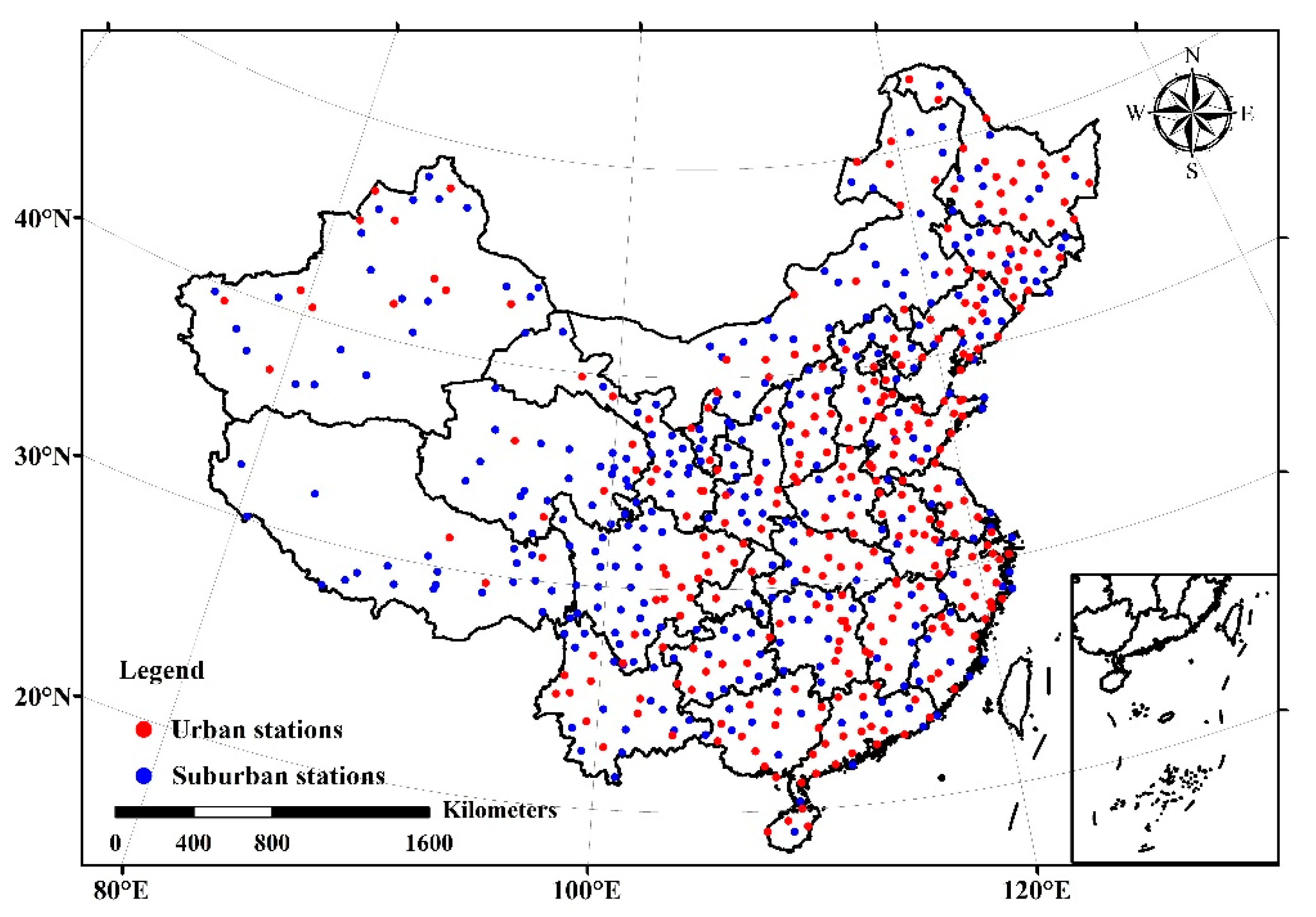
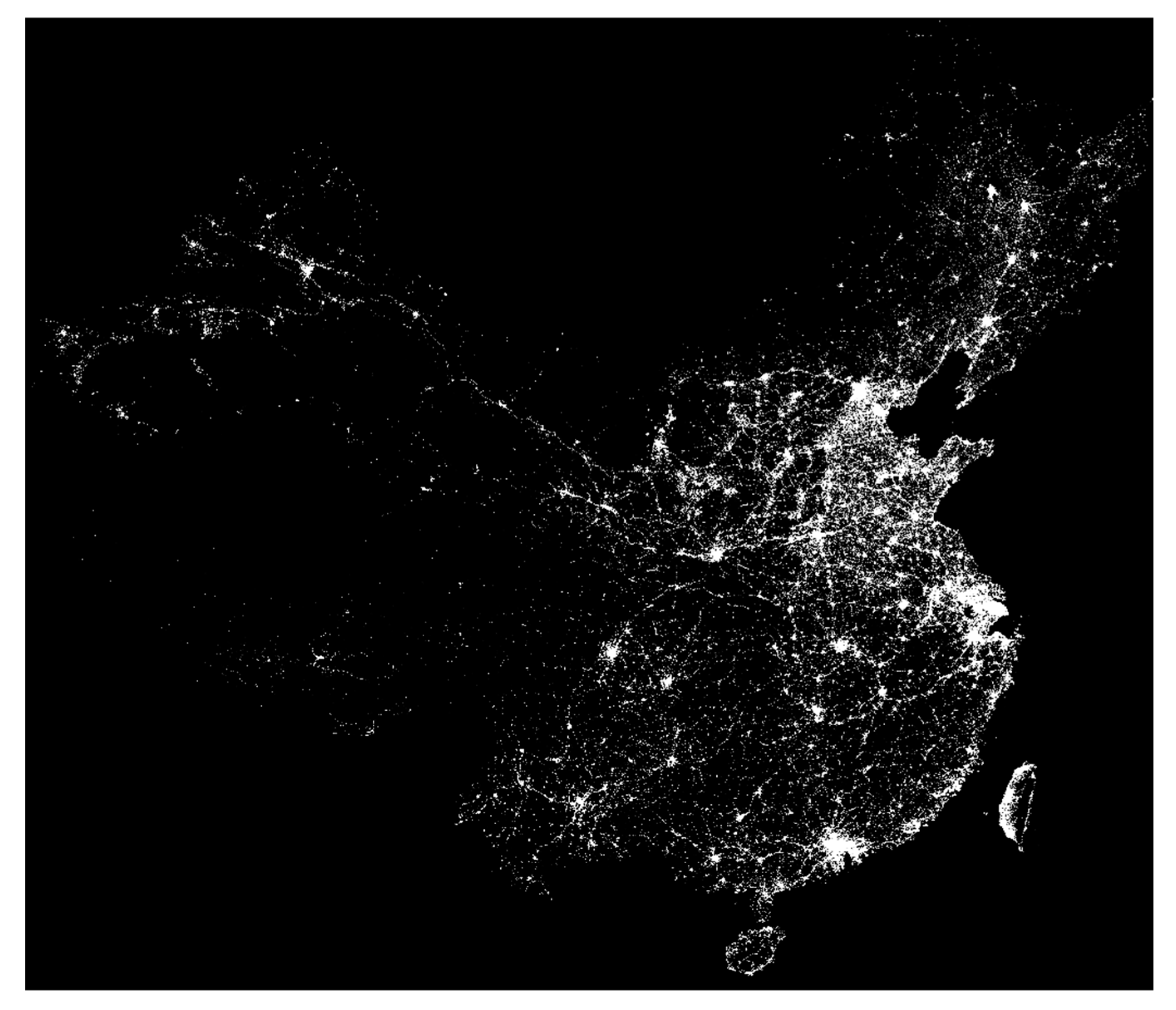
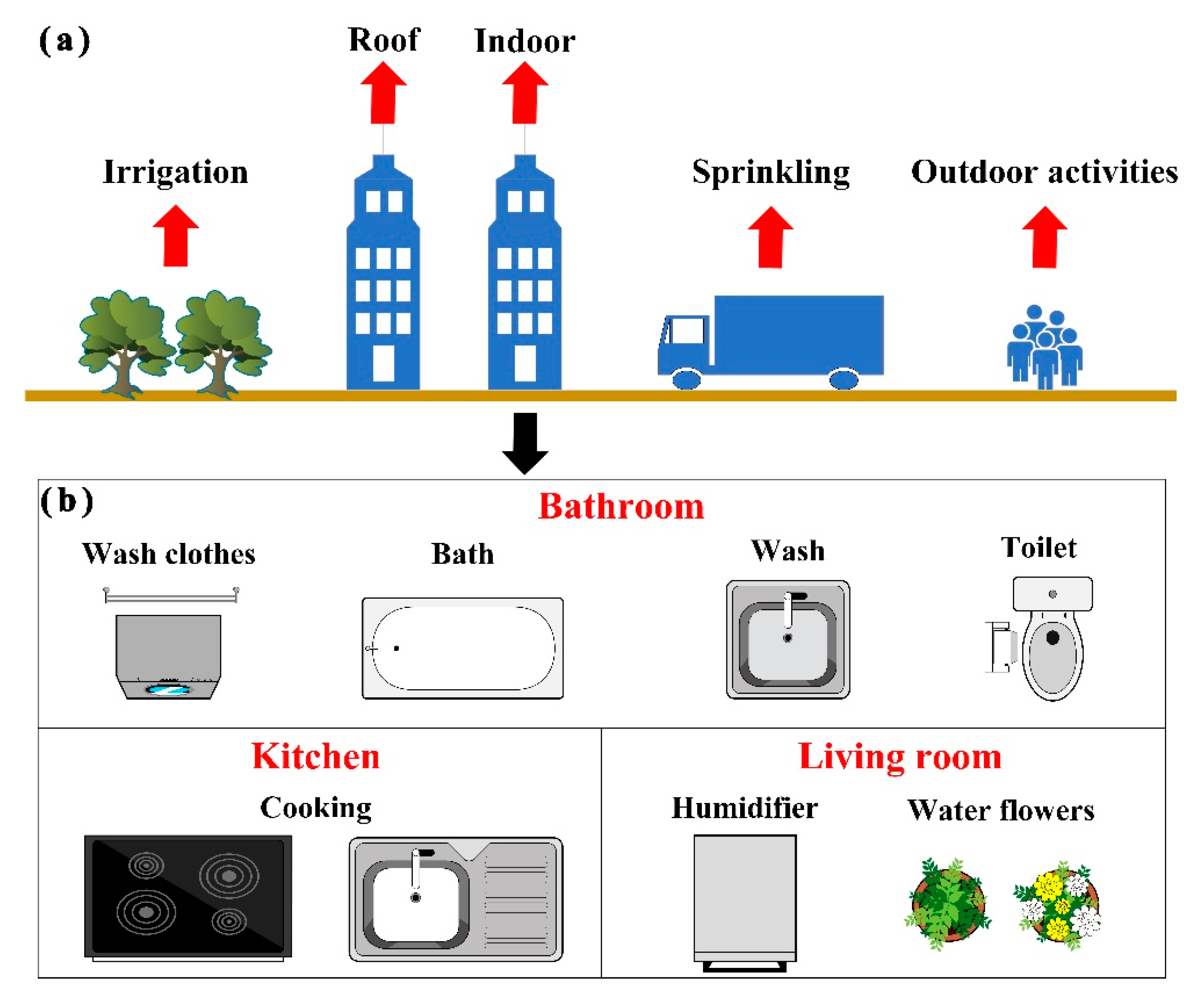
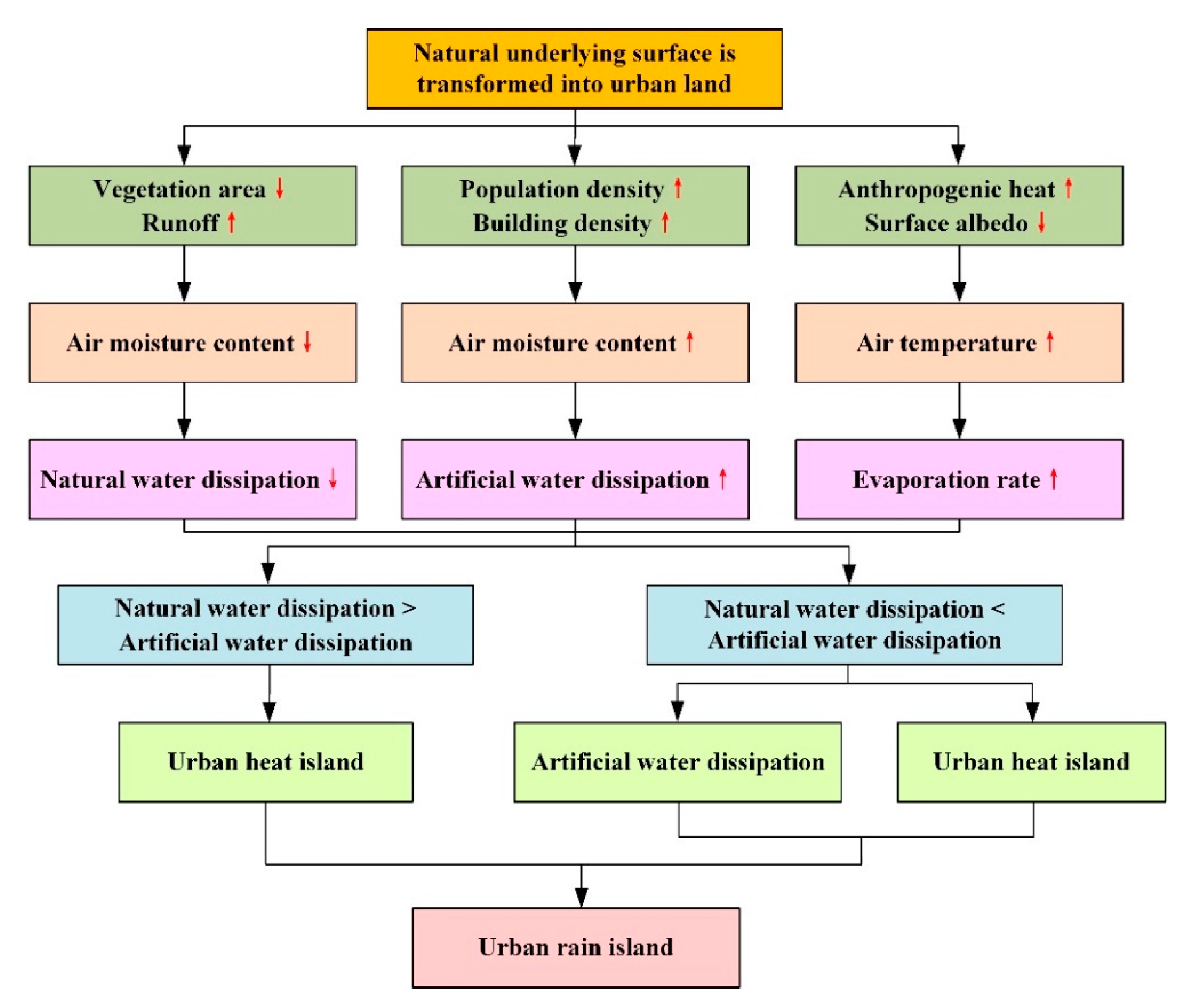
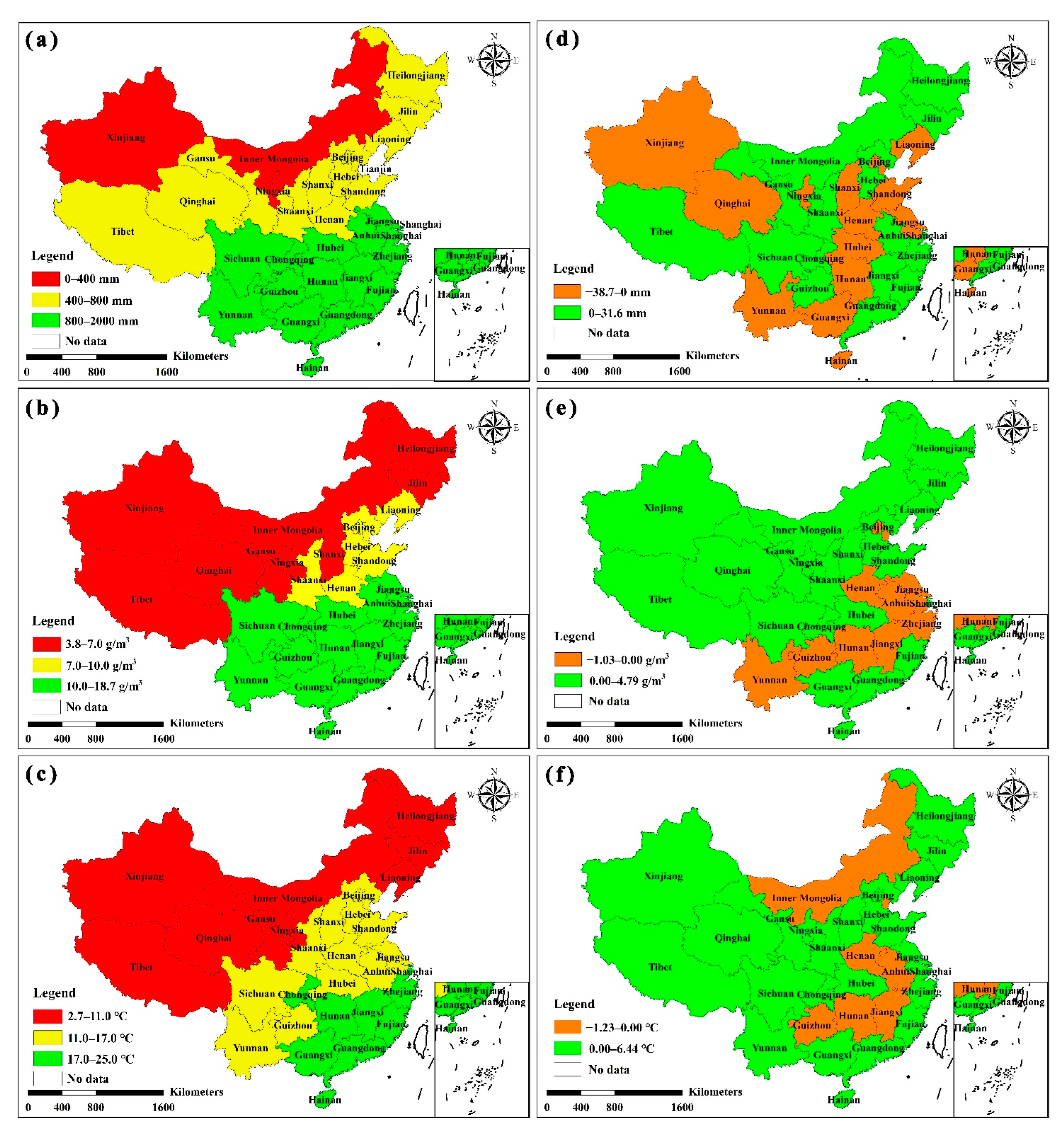
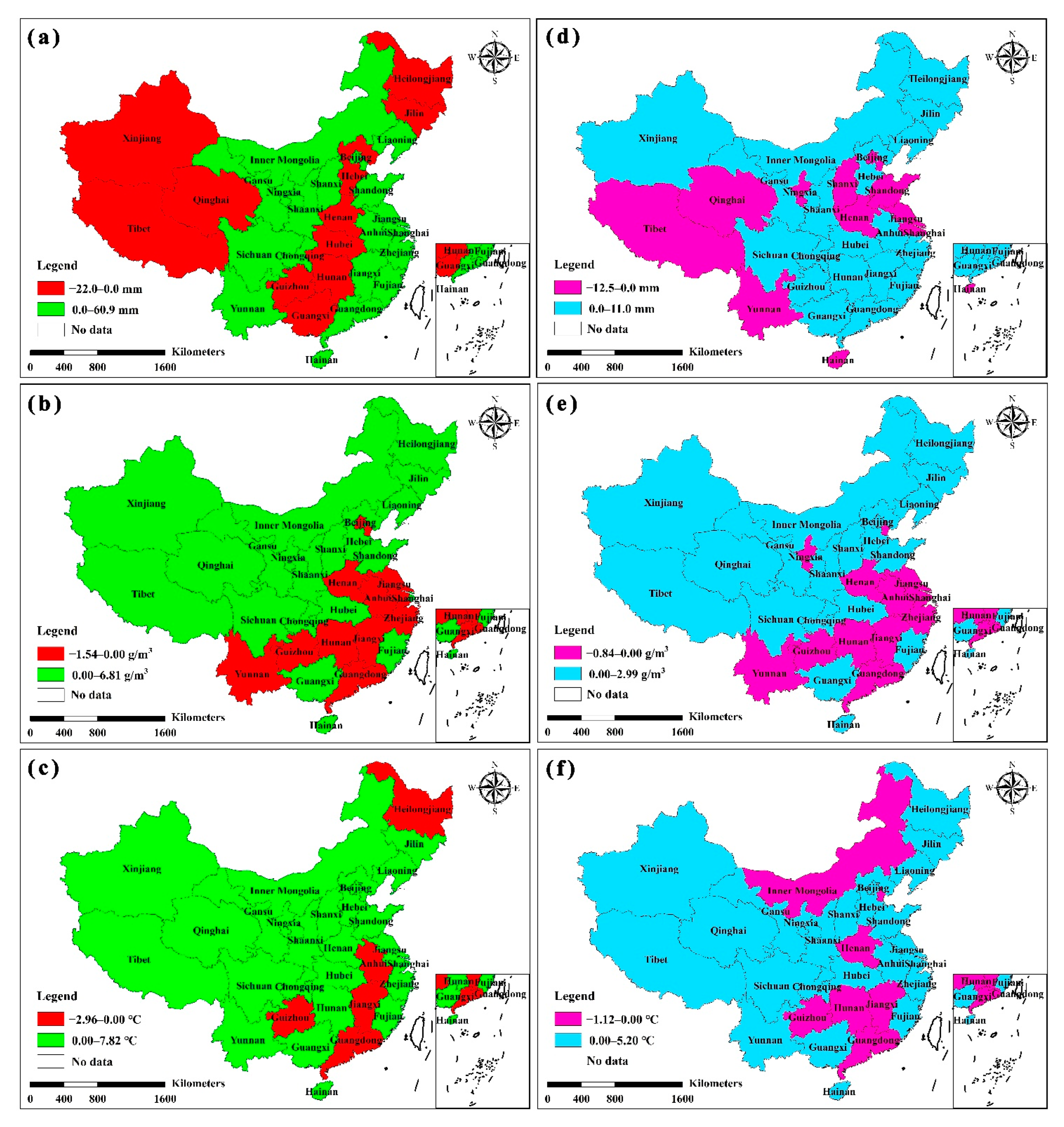
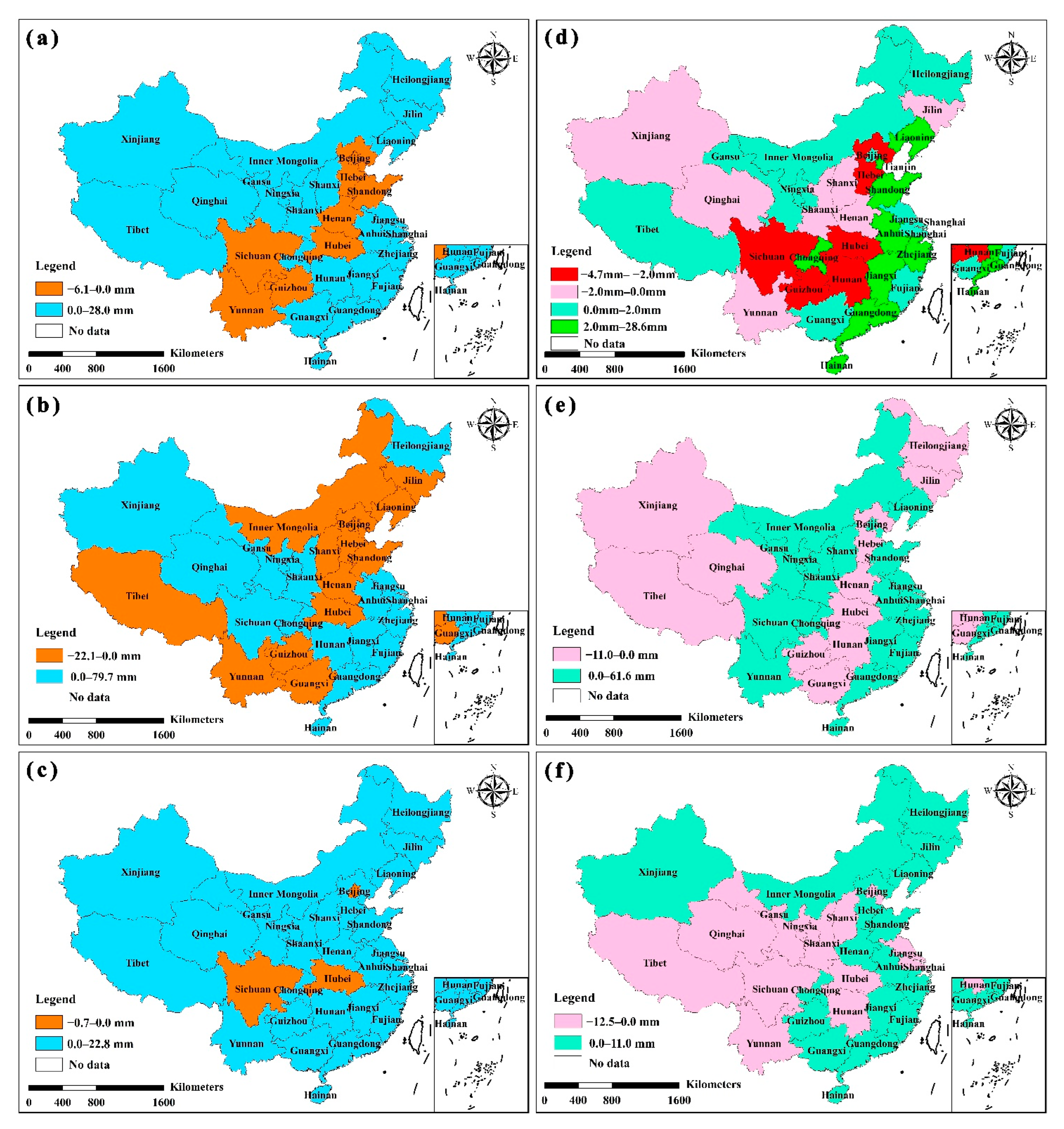
| Province | Urban Stations | Suburban Stations | Urbanization Rate (%) | Province | Urban Stations | Suburban Stations | Urbanization Rate (%) |
|---|---|---|---|---|---|---|---|
| Shanghai | 1 | 1 | 88.67 | Shanxi | 10 | 8 | 54.24 |
| Beijing | 1 | 1 | 86.36 | Shaanxi | 8 | 13 | 53.11 |
| Tianjin | 1 | 1 | 82.16 | Jiangxi | 11 | 7 | 50.97 |
| Guangdong | 17 | 9 | 68.62 | Hebei | 12 | 8 | 50.88 |
| Liaoning | 13 | 10 | 66.37 | Hunan | 11 | 11 | 50.46 |
| Jiangsu | 8 | 4 | 65.83 | Qinghai | 5 | 23 | 50.22 |
| Zhejiang | 13 | 5 | 65.63 | Anhui | 13 | 4 | 49.87 |
| Fujian | 10 | 7 | 62.14 | Sichuan | 16 | 28 | 47.11 |
| Chongqing | 2 | 2 | 60.40 | Xinjiang | 12 | 22 | 47.03 |
| Inner Mongolia | 14 | 25 | 59.78 | Guangxi | 12 | 7 | 46.26 |
| Heilongjiang | 20 | 12 | 58.28 | Henan | 10 | 5 | 46.13 |
| Shandong | 20 | 9 | 56.19 | Yunnan | 11 | 16 | 42.55 |
| Hubei | 9 | 8 | 56.12 | Gansu | 9 | 16 | 42.48 |
| Jilin | 15 | 12 | 55.31 | Guizhou | 7 | 10 | 41.25 |
| Hainan | 4 | 1 | 54.76 | Tibet | 3 | 20 | 27.04 |
| Ningxia | 4 | 6 | 54.33 |
Publisher’s Note: MDPI stays neutral with regard to jurisdictional claims in published maps and institutional affiliations. |
© 2022 by the authors. Licensee MDPI, Basel, Switzerland. This article is an open access article distributed under the terms and conditions of the Creative Commons Attribution (CC BY) license (https://creativecommons.org/licenses/by/4.0/).
Share and Cite
Luo, Z.; Liu, J.; Zhang, S.; Shao, W.; Zhou, J.; Zhang, L.; Jia, R. Spatiotemporal Evolution of Urban Rain Islands in China under the Conditions of Urbanization and Climate Change. Remote Sens. 2022, 14, 4159. https://doi.org/10.3390/rs14174159
Luo Z, Liu J, Zhang S, Shao W, Zhou J, Zhang L, Jia R. Spatiotemporal Evolution of Urban Rain Islands in China under the Conditions of Urbanization and Climate Change. Remote Sensing. 2022; 14(17):4159. https://doi.org/10.3390/rs14174159
Chicago/Turabian StyleLuo, Zhuoran, Jiahong Liu, Shanghong Zhang, Weiwei Shao, Jinjun Zhou, Li Zhang, and Ruitao Jia. 2022. "Spatiotemporal Evolution of Urban Rain Islands in China under the Conditions of Urbanization and Climate Change" Remote Sensing 14, no. 17: 4159. https://doi.org/10.3390/rs14174159










